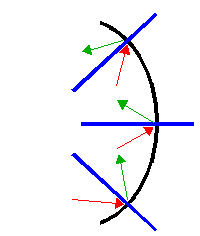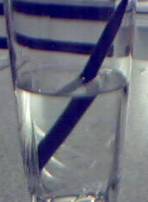We will be looking at some of this material again later on in the course, but for now we need to make sure you have basic idea of what is going on.
- Of the three, you’ll probably find reflection by far the easiest to understand… don’t look for some secret hidden meaning in it!
- Refraction and diffraction are a bit tougher, but for now we are just trying to explain them. Later we will use formulas to figure out refraction.
Each one will be identified at the start as a property of waves, particles, or both.

Reflection
There is nothing really mysterious about reflection, but some people try to make it more difficult than it really is.
- In physics, drawings that show reflection always include a special line that must be drawn first... the normal.
- You might remember this word from when we studied forces. We say that a line drawn at 90° to the surface is a normal line.
- When you want to figure out how something will reflect from a surface, draw a normal line to that surface at that point.
Look at the following diagram:

The angle of incidence equals the angle of reflection.
The angle that we are referring to is the angle between the normal line and the incident/reflected wave coming in.
- Notice how the incident wave coming in is at an angle of 42° from the normal. When it reflects off the surface it bounces off at an angle of 42° from the normal. The two angles are equal!

The only time you need to be really careful with the law of reflection is when the surface is somehow irregular.
- You still draw normal lines, you just have to be very careful that it is at 90° to the surface at that point.
- If the surface is curved (which we will examining detail later), you will draw a whole bunch of normal lines for many points on the surface.
- You still draw the incident and reflected waves the same way relative to the normal lines, you just have to be careful about how you draw those normal lines.
- Sometimes you might have a surface that is really irregular… a whole bunch of random bumps. You still draw normal lines, but they’ll be pointing in all sorts of weird directions.
Refraction

Refraction
Refraction has to do with the bending of waves when they travel at an angle from one medium to another.

- Have you ever looked at something like a pencil or pen sitting in a cup of water? It probably looked something like this…
- Notice how the pen looks like it is bent and bigger in the water… something must be happening to the light waves as they travel through two different substances… water and air.
- The way the waves is moving is changed by moving to a different medium. This is something we didn’t consider up until now since we had been drawing waves that hit boundaries head on.
- When we get into the section on light waves we will look at a formula called Snell’s Law that will let us calculate how much light is bent.
- For now you only need to know what refraction is by definition.

Diffraction
Diffraction is the ability of waves to bend around obstacles or through openings.
- You’ve seen this if you’ve ever watched water waves as they spread out after passing through an opening.
- You might have also seen waves pass an obstacle like a pier. Instead of leaving a gap cut into the waves, the waves bend together and close up the gap.
- Particles don’t do this, only waves can.
- Particles will only travel in straight lines if they encounter opening or obstacles, but waves can do this little bending trick.
- It is one of the big differences between waves and particles.